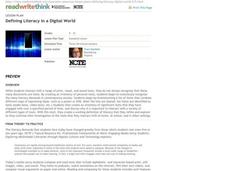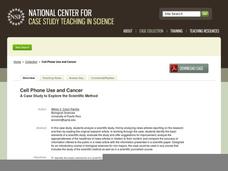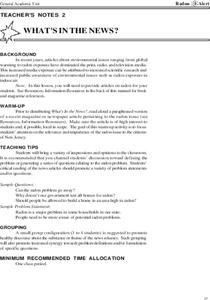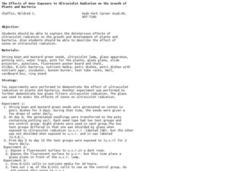ReadWriteThink
Defining Literacy in a Digital World
What skills are necessary to interact with different types of text? Twenty-first century learners live in a digital world and must develop a whole new set of skills to develop media literacy. Class members engage in a series of...
Curated OER
Techniques Used to Convey Media Messages
Students consider the impact of media messages. In this media awareness lesson, students discover the types of media techniques employed in advertising and share examples of each as they create media message collages.
Curated OER
Elements of Messages
Students examine media messages. In this media awareness lesson, students analyze political cartoons and identify the literary elements they incorporate. Students also use the Media Elements Handout to identify the elements in other...
Curated OER
Twenty-Five Great Ideas for Teaching Current Events
Teaching current events can be an amazingly-rewarding part of your teaching week. This resource presents twenty-five ways to incorporate current events into your curriculum. It offers some outstanding ideas, such as providing your...
Curated OER
Parliamentary Newsroom : Developing Media Literacy
High schoolers explain and examine the selection, development, sources, transmission and impact of news on the public. They write a brief essay on the topic: "The Public Must Be Critical In Their Assessment of the News Before Drawing...
Curated OER
Using the News in Class
Students listen to international news stories. Students use context clues to determine the meaning of vocabulary words from context, then complete a matching exercise to see if their vocabulary definitions were correct. Students...
K20 LEARN
The Bank Of Justice: Civil Rights In The US
To launch a study of racial segregation and integration, young historians first watch a news video about a prom in Georgia that was first integrated in 2013. They then compare the goals in Lincoln's Gettysburg Address to King's "I Have a...
Curated OER
High Exposure
Young scholars interpret data they receive from the media, discuss possible misinterpretation of data from the media and correctly respond to the misconception quiz question.
Curated OER
Beneath the News: Who's Doing What to Whom, and Who Cares?
Students investigate the differences between various forms of media (print, radio, TV, Internet). They determine the target audience for each and compare exposure around the world. They write a short story and share it with the class.
Curated OER
Media and Society
Students rank public figures and decide what makes a good citizen.Working in pairs students design their own way of assessing contributions to society. The following contributions are examined for evaluation: Helping others, obeying the...
Curated OER
Science in the News
Students explore science in the news through articles, magazines, and internet news sites. They select articles, read them and summarize them to identify the audience that would care about their topics. As they present their articles...
Curated OER
Ask a Librarian
Discuss how asking questions is a vital part of not only the research process, but the lifelong process of information literacy. Middle schoolers work in small groups and practice the skill of asking questions. Afterward, they complete...
Curated OER
Who, What, When, Where, Why, and the Media
Students in a preschool classroom discuss potentially fearful current events in a way they can understand. They write or draw about a current event, discussing the 5 W's of news reporting.
National Center for Case Study Teaching in Science
Cell Phone Use and Cancer
The cell phone you're using is making you deaf: news at 11:00. Oftentimes, the media uses fear tactics and other techniques to increase its audience base. In an intriguing look at the difference between scientific journals and...
Curated OER
Re-Searching
Students take a closer look at the research cycle. In this journalism lesson, students discover and practice Internet searching skills. Students use the search techniques discussed to locate information on selected topics.
Curated OER
What's in the News?
Students discuss any news article or video about the environment. They develop their own questions relating to radon and how it effects people and the environment. They answer each others questions to end the lesson.
Curated OER
Classroom Content
Students examine the roles that scientists and government agencies play in protecting citizens from commercially produced chemicals. They watch a video, conduct Internet research, and prepare a media presentation.
Curated OER
The Effects of Over Exposure to Ultraviolet Radiation on the Growth of Plants and Bacteria
Students investigate the effects of UV light and ozone on plant and bacteria growth. In this ultraviolet light and ozone lesson plan, students grow bean and mustard greens to study the effects of UV light and ozone on the plant growth....
Curated OER
Writing Prompts for High School
Are you teaching a high school language arts class and stumped for writing topics? Five pages of writing prompts for all kinds of writing should help you out. Many of these prompts refer to texts that are not included in this resource,...
PBS
Stories of Painkiller Addiction: Decisions and Consequences
Teach young learners that most drug addictions end in one of three outcomes: treatment, jail, or death. After watching a short video segment on the consequences of drug abuse, class members discuss what they viewed and consider what...
Curated OER
Leveled Vocabulary for And Then There Were None
Chaotic, perjury, tenacious, vague, predatory, idiosyncrasy. Using Marzano and Brown’s six steps of direct instruction for vocabulary (choose, restate, illustrate, use, discuss, play) readers of And Then There Were None engage in a...
Curated OER
Can You Name That Shape?
Learners use materials to build, investigate, and draw two-dimensional shapes (polygons). They combine the shapes they have built and draw from the pile to begin a round-robin activity to name and determine the attributes of a selection...
Curated OER
STD & AIDS, Day 2: Sexually Transmitted Diseases (STDs)
Keep your secondary special education class informed and aware of STDs, HIV, and AIDS. They learn what STD stands for, how STDs are transmitted, and how to protect themselves. A case study, note to care provider, handouts, transparency,...
Virginia Polytechnic Institute and State University
Lesson Plan: Successful Microwave Cooking
No need to be involved in a home economics or cooking courses to take advantage of this resource. Not only is there an explanation for how microwaves work but there are also tips for how to use the microwave, and cautions...
